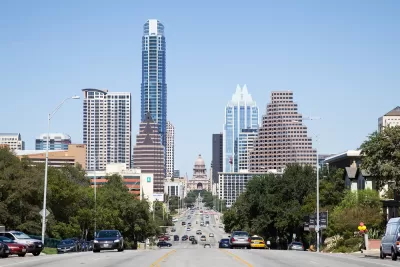A local blogger takes umbrage with claims that Austin's density is causing its traffic problems. The obvious problem with that argument: Austin is 68% as dense now as it was in 1950.

A post by Carrie Gammell at Car Free Austin argues against the idea that Austin's traffic problems are created by density alone: "While it may appear that our present-day city is more crowded and the traffic less manageable, that feeling of encroachment is most certainly due not to an increase in people but to an increase in cars, an increase in asphalt."
In a key passage, Gammell cites both the prevailing rhetoric about traffic in Austin, as well as the inherent irrationality of such arguments:
It seems that local media outlets constantly bemoan the statistic that 110 people move to Austin on an average day. Tall buildings, skyscrapers, 10-to-50-story buildings full of people are presumably to blame. Meanwhile, the city is still not as dense as it was in 1950, 1960, 1970, or 1980.
In fact, 2015 Austin is only 68% as dense as 1950 Austin.
The post offers a lot more detail about the city's planning and transportation decisions of the late-20th century and a collection of historic aerial photos.
Hat tip to Angie Schmitt at Streetsblog USA for finding and sharing the post.
FULL STORY: Density Does Not Cause Traffic

Maui's Vacation Rental Debate Turns Ugly
Verbal attacks, misinformation campaigns and fistfights plague a high-stakes debate to convert thousands of vacation rentals into long-term housing.

Planetizen Federal Action Tracker
A weekly monitor of how Trump’s orders and actions are impacting planners and planning in America.

San Francisco Suspends Traffic Calming Amidst Record Deaths
Citing “a challenging fiscal landscape,” the city will cease the program on the heels of 42 traffic deaths, including 24 pedestrians.

Defunct Pittsburgh Power Plant to Become Residential Tower
A decommissioned steam heat plant will be redeveloped into almost 100 affordable housing units.

Trump Prompts Restructuring of Transportation Research Board in “Unprecedented Overreach”
The TRB has eliminated more than half of its committees including those focused on climate, equity, and cities.

Amtrak Rolls Out New Orleans to Alabama “Mardi Gras” Train
The new service will operate morning and evening departures between Mobile and New Orleans.
Urban Design for Planners 1: Software Tools
This six-course series explores essential urban design concepts using open source software and equips planners with the tools they need to participate fully in the urban design process.
Planning for Universal Design
Learn the tools for implementing Universal Design in planning regulations.
Heyer Gruel & Associates PA
JM Goldson LLC
Custer County Colorado
City of Camden Redevelopment Agency
City of Astoria
Transportation Research & Education Center (TREC) at Portland State University
Jefferson Parish Government
Camden Redevelopment Agency
City of Claremont





























